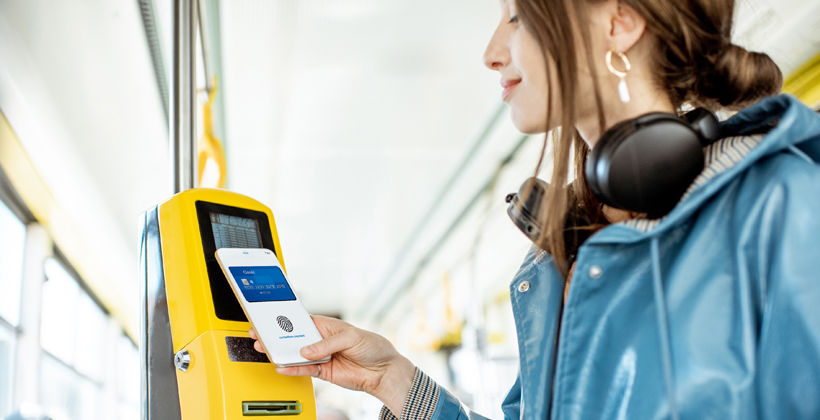YOU and THEM: Advantages of Open-Loop Ticketing
Open-loop payments have become the new norm for the transportation industry. Cash, which is expensive to handle, hard to process and slower in transaction than digital payments, is slowly losing its authority among various public service operators.
With more than 1.5 million people joining urban zones each week, according to PWC, more travellers than ever are experiencing bottlenecks in transport stations, at cashiers and on intercity routes. Because of this, transport operators are looking for ways to increase the velocity of onboarding, reduce journey times and make journeys more comfortable for passengers. This would eventually mean an increased retention rate and raised revenues.
This can be observed through the evolution of payment methods, which transformed from cash to value-stored cards, to transport multi-use cards, open-loop cards and account-based ticketing, and methods that do not even require physical cards. Each step forward improved control over fares, reduced the time for onboarding and enhanced security and speed of operations.
As reported by Visa, a further 50 cities globally introduced open-loop payments that included acceptance of Visa-branded cards and NFC wallet credentials over six months in 2022, and more than 500 transit agencies around the world started accepting EMV in 2022. That number continues to grow.
What is Open-Loop?
Pay-as-you-go or open-loop payments can be made via any contactless device, such as a plastic card, QR code, BLE, NFC or Mobile ticketing, which is increasingly in demand. In contrast, closed-loop systems only allow payment via value-stored cards or transport cards issued by the operator directly and distributed to the passengers.
Due to the significant popularity and spread of EMV technology that covers large payment networks such as Visa, MasterCard, Diners, Amex, JCB, CUP etc, the chance the traveller possesses those types of cards is high. With over 2.5 billion Visa cards worldwide, there is an approximate 30% chance that a person would carry a Visa card on public transport.
Why would you, as a transport operator, miss this 30% potential market share? Open-loop technology is beneficial for you and those you serve.
What’s to Gain from Open-Loop?
Central fare management and data
By digitalising your fare collection system and introducing open-loop payments, cash processing is no longer required. Contactless payments reduce both operating costs and costs associated with processing currency.
Operators can manage their systems centrally from a web app, observing all the transactions, routes and velocity of operations. Accessibility to additional digital data provides major benefits for the operator. They can observe the most loaded routes during the week and seek solutions for offloading jams, and gather, analyse and build prediction models on traffic. This improves services and reduces unnecessary costs, reducing the number of vehicles running half-empty during low-traffic times.
While managing traffic load is important, gathered statistics can help transport operators to analyse demand for the services during various times, helping to optimise the fare structure and type and centrally update it on all routes, saving on time and operational costs.
Interoperability
Being agile and flexible is another way public transport operators can stay competitive. With unified contactless payment methods, it is easier for transport operators to add various new fleet types to their business without the need to reprogram any closed-loop cards or instruct the cashiers. The global interoperability of payment methods provides additional accessibility to the services.
Unifying the ticketing experience for the passengers through open-loop automated fare collection increases operational efficiency. It also provides seamless commuter journey experiences to those who need to take more than one mode of transport from A to B.
Easy integration with new partners
The technology allows transport service operators to easily integrate with partners and improve cross-sell channels since contactless payments are already part of the day-to-day operation. Transport operators levy the costs of upgrading the cards and means of payment since payment methods are unified.
In addition, introducing contactless methods of payments eases enrollment to services, boosting velocity and transactional daily volume, as well as the reputation of the routes.
Addressing the Need for Better Traveller Experiences
Transforming the business to contactless also benefits commuters, who are familiar with technology and appreciate seeing simplicity and swiftness in operations.
Secure, transparent payment
It's been proven that EMV technology is a safe method of payment, reducing card fraud and securing contactless operations. Introducing open-loop payments provides commuters with transparency of fares as well as reducing the chances of skimming and theft.
In addition, modern systems of automated fare collection provide multi-language support, which removes asymmetry of fare information for the traveller due to language barriers, further reducing fraudulent and dispute cases.
O-CITY provides commuters with a 360-degree view of tariffs, costs and historical data. Payment for different means of transport can be made via their account, where the user stores card information. By linking fleet infrastructure to O-CITY, operators allow customers to travel freely using only a mobile phone or wearable device, track changes on their routes and feel part of the smart city environment
Intermodality
Travelling using more than one transport mode is quite widespread in megacities and during long-distance journeys. Commuters always try to search for the optimal route, whether that means the lowest cost or the shortest journey time. UITP states that many city dwellers use at least two different transportation modes to reach their destination. Introducing open-loop ticketing and allowing various payment methods on routes, the transport operator opens the way to seamless transport connections for its commuters on their journey. Open-loop payments improve accessibility of public transport for the end-users, while boosting the reputation of the transport operator. Routes with EMV and alternative payment methods accepted will be passengers’ number one choice when planning a trip.
Various payment options
Lastly, introducing open-loop technology provides various payment methods to the end-user, who can validate the journey through plastic card, wearables, NFC, RFID, QR-code, Biometry, Bluetooth or Mobile device. This increases services accessibility for locals and tourists, as well improving ease of enrollment for new commuters.
More and more cities have started to introduce open-loop account based ticketing, read about some successful implementations.


